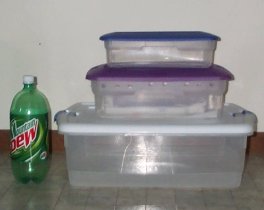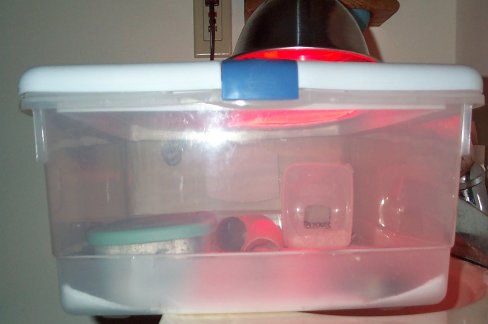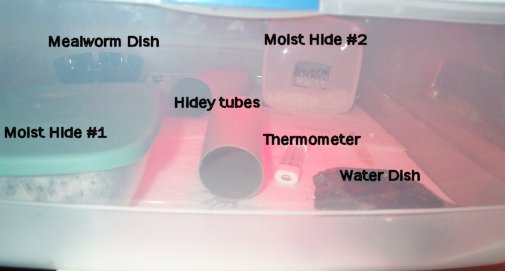
Housing Leopard Geckos
Housing your gecko properly is very important, and there are a lot of right ways to do it! This page is to show you how we do it, as well as discussing some common housing solutions. Many people use a 10 gallon aquarium with a snug-fitting lid (very important) to house their geckos. This looks nice, because you can decorate it naturalistically and you can house one male or up to about three females in a 10 gallon.Plastic rubbermaid or sterlite containers are a common alternative. The general rule of thumb is that a hatchling can live in a plastic shoe box, an adult male in a plastic sweater box, and a group of females in the larger under-bed containers. The pictures below demonstrate the size differences (a 2 liter bottle is in the picture to help you get an idea of proportion):


Please note that the ventilation holes in the sweater box are larger than I'd recommend for geckos; an appropriate size hole can be easily made by melting with a sautering iron or a drill bit. If you drill, they tend to crack, but a sautering iron melts through the plastic as easily as butter!
We are housing our females 5 per box in the large under-bed size box. For ventilation, we cut a hole in the top (heat plastic with a blow dryer to soften and cut with a utility knife) and taped in a panel of plastic canvas. The light sits over the ventilation hole. The photos below show how one of our girls' cage is set up.


The final photo below shows the inner furnishings in the page. We use paper towels or newspaper for substrate because it's easy to clean, and our girls are still small. Sand or soil substrates aren't recommended for leopard geckos under 6" long since they often eat the sand and can get impacted (which can be fatal). We feed both crickets and mealworms, making the mealworms available 24 hours a day, and just offering the crickets once every evening. They need a moist hide-box, to help them shed. Our hide boxes are small plastic containers with a hole cut in the side where the geckos crawl in. We use perlite in the bottom, mixed with enough water to make it damp. We also have toilet paper tubes for dry hidey places. There's a dish of calcium powder (you can't see it in the picture, it's hidden by the moist hide at the front) and a low water dish. Finally, there's a thermometer. We got one in the kitchen section of Wal-mart for about $2. We've measured the temperatures below the lamp (which uses a 25 watt red light bulb) and it stays about 88 degrees there. In the furthest corner of the cage, it stays about 72 to 74. This gives the geckos a temperature gradient, so they can decide where they are most comfortable. It is important to note that the purpose of the lamp is to create a warm spot for the geckos to bask, which aids their digestion. Being nocturnal, leopard geckos need only ambient sunlight and don't need special UV lights. An under tank heating pad or an overhead light are both good solutions to their need for a warm area in the tank. Just make sure it isn't over 90 in the warm area and that it's about 70 to 75 in the coolest reaches of the tank.

Last updated 7/16/01